
Lupine Publishers Group
Lupine Publishers
Menu
ISSN: 2637-4609
Research Article(ISSN: 2637-4609) 
Flavonoids as Chemotaxonomic Markers in the Leaves of Plant Family Malvaceae in South Kordofan, Blue Nile and Khartoum States- Sudan Volume 4 - Issue 3
Asaad Alsiddig Ahmed1, Abdelgabbar Nassir Gumaa2, Mahdi Abdelmageed Mohammed3 and Hatim MY Hamadnalla4*
- 1Department of Chemistry, Faculty of Laboratory science, Sudan
- 2Department of Biology, University of Khartoum, Sudan
- 3Department of Biology & technology, University of Bahri, Sudan
- 4Department of Biochemistry, University of Bahri, Sudan
Received: February 26, 2020; Published: March 12, 2020
*Corresponding author: Hatim MY Hamadnalla, Department of Biochemistry, College of Applied Sciences, University of Bahri, Sudan
DOI: 10.32474/AOICS.2020.04.000189
Abstract
This work is a taxonomic study on flavonoids in the leaves of selected species belonged to family Malvaceae. These species considered as: Abelmoschus esculentus, Hibiscus sabdariffa and Gossypium barbadense. These species distributed in different localities in Sudan. The selected members have nutritive, medicinal and economic importance, extra of that, the present study included botanical and chemical studies. The collected species have been updated due to nomenclature and synonymy. The geographical distribution of the selected members has been indicated. The chemical studies included identification of the flavonoid compounds using Gas Chromatography Mass Spectrophotometer (GC - MS). Eighty-three flavonoid compounds were detected in the leaves of family Malvaceae. The highest number (36) was detected in the leaves of Abelmoschus esculentus. Five flavonoid compounds were identified as taxonomic markers for the leaves of Hibiscus sabdariffa. Thirteen flavonoids were restricted only to the leaves of Gossypium barbadense.
Keywords: Chemotaxonomy; Medicinal Plant; South Kordofan; Blue Nile and Khartoum states; Sudan
Introduction
Flavonoids or bioflavonoids mean yellow in Latin language with reference to their color in nature and they represent the plant secondary metabolites. Flavonoids are poly phenolic compounds possessing (15) carbon atoms with a leaner three carbon chain. They also constitute one of the most characteristic classes of plant compounds. Flavonoids are easily recognized as ‘’flower pigment’’ in the most angiosperm plant families. However, their occurrence is not restricted to flowers but included all the parts of plants. This compiled by John et al. [1]. (The flavonoids have many classes such as chalcone, flavones, flavanones, flavanols, anthocyanidins and is flavonoids. These are synthesized by the plants beside (4000) other compounds identified by their food sources. The flavonoids may contribute to some of the health benefits associated with diets rich in fruit and vegetable. Offering a wide range view of these classes of plant pigments after brief examination of history and literature of flavonoids there were sub-classes of flavonoids using multiple techniques for isolation, purification and determination of structures. Wilkomirsk et al. [2].
Study Area
South Kordofan state (Western Sudan) lies between latitude 11° - 37. 96’ N and longitude 29° - 42’ E. Blue Nile State lies between latitude 11° - 09’ N and longitude 34° - 06’ E and khartoum lies between latitude 15° - 33’ N and longitude 32° - 31 E. North Kordofan climate characterized as hot days and cold nights, sunny and partly clouds with relatively short rainy seasons. The area of the study mostly sand of yellowish red sandy loam. Blue Nile state climate depended on change of seasons and with result in a likely decline in stream flow which increases the soil moisture. Khartoum state climate change characterized as temperatures are rising, soil fertility is low, and wind blows dusty and also mostly desert with receive barely rainfall.
Population
According to ethno-botanical, South Kordofan is an interesting state; it includes several people such as Arabs and Africans. The tribes in this state depend on (millet, sorghum, groundnuts and sesame) for nutrition, also their activities characterized as pastoral (cattle and goats). Blue Nile state is host to round forty different ethnic groups, its economic activity based on agriculture and livestock and increasing mineral exploitation, while Khartoum state composed of various tribes distributed in many localities, most of population works in government services, private sectors and banking. Khartoum represents the capital city because it contains governmental and non-governmental organizations and also include the main airport.
Methodology
Field work
The study was conducted during September - November 2013 in three localities in Sudan, namely, South Kordofan, Blue Nile and Khartoum. The information’s of the present study were gathered through three steps collection, preparation and chemical analysis. The results obtained by a coupled system named (GC - MS) in the central laboratory of the University of Khartoum, 2013. This coupled system was integrated composite analysis to separate and quantify components. The (GC) apparatus configured by adjusting temperature, pressure and time. The (MS) identified the components. The plant material was washed thoroughly with running tap water followed by rinsing with distilled water. The material was then air-dried and ground manually using a marble mill. The powder of the roots was then passed into sieves of different sizes (Retsch, German). One (ml.) of methanol (70%) was added to one (gm.) of the powdered leaves. The solution was then injected to (GC).
Data Analysis
Table 1: Medicinal applications of the leaves of the selected species of plant family Malvaceae in South Kordofan, Blue Nile and Khartoum states.
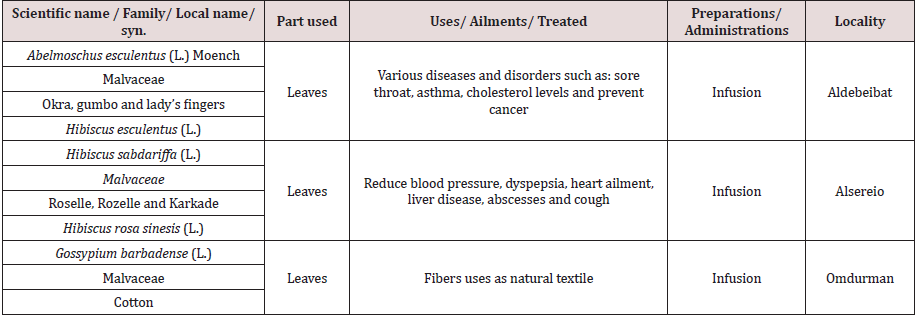
Table 2: Pairing affinity between the studied members of family Malvaceae based on the selected flavonoids in the leaves.
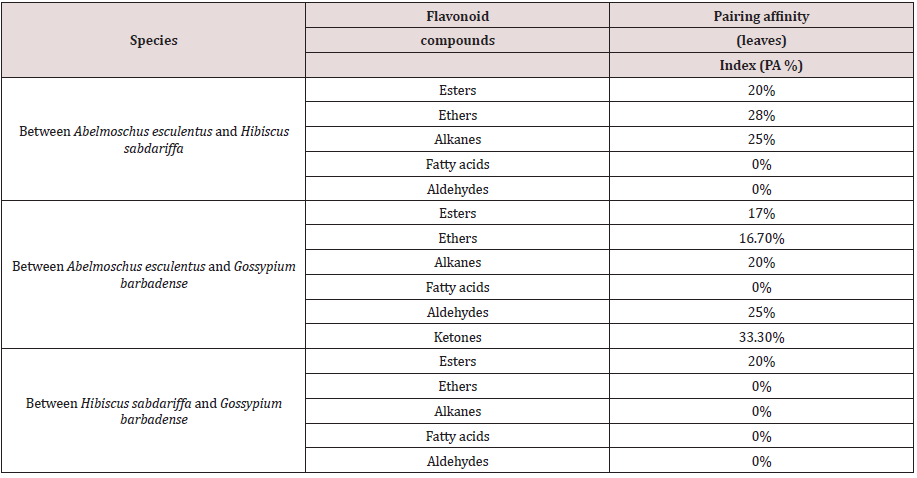
All the data illustrated have been integrated and analyzed. The results have been structed according to these categories: number of plants mentioned with (scientific names, botanical families and vernacular names). The references were complete in central laboratory. Study of quantitative was also performed using frequency per species and was estimated by calculation of the plant sites [Table 1&2].
Discussion
Figure 1: The relationship between time and intensity of fragmentation which produced peaks in the leaves of Abelmoschus esculentus. Abbreviations and formulae of calculation.
R. time = retention time. % area = area of peak X 100%
I. time = initial time. Total area
F. time = full time. % height = height of peak X100%
Total height
TIC = (total ions chromatography)
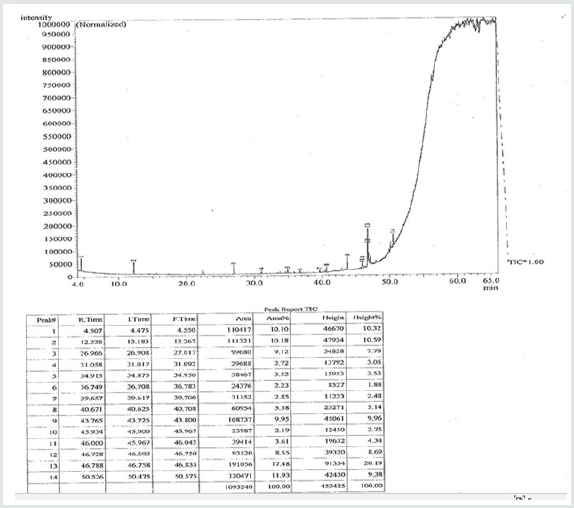
The data detected in this study were compared with the related literature and also published reports on the traditional medicinal uses of the plants. The species named as: Abelmoschus esculentus [Figure 1], Hibiscus sabdariffa and Gossypium barbadense. The selected parts were leaves. The number of the flavonoid compounds of the selected members of family Malvaceae in the leaves were (83) compounds. The major flavonoid compounds in the leaves of Abelmoschus esculentus and Hibiscus sabdariffa [Figure 2]were: hendecane, 2-methoxy-3-methyl butaric acid methyl ester, decane-1,1-oxy bis decyl ether and 3-ethoxy-1,1,1,7,7,7-hexamethyl-3,5,5-tris (trimethyl siloxy) tetrasiloxane. This result was confirmed in the present study. The number of the flavonoid compounds in the leaves of Abelmoschus esculentus were (36), the numbers of the flavonoid compounds in the leaves of Hibiscus sabdariffa were (21) and the number of the flavonoid compounds in the leaves of Gossypium barbadense [Figure 3]were (26). The flavonoid myricetin and kaempferol were reported by many authors in different plant parts of plants such as William & Buttery [3,4]. However, none of these flavonoids were found in the leaves of the selected members. This may be due to environmental factors or soil moisture. The phenolic acids: malic, tartaric and citric acids were found in the calyx of Hibiscus sabdariffa and not found in the leaves of the same plant. The flavonoid compounds octadecanoic acid-2,3- dihydroxy propyl ester, citronelly propionate, 1,5- diazacycloheptadecan-6-one {(4-methyl phenyl) sulfonyl} and 7-hexadecenal, (Z) were detected in all the leaves of the selected species of family Malvaceae. The flavonoid 9-octadecenoic acid -1,2,3- propanetriyl ester E, E, E was found by Donatus et al. [5]. in different species named Alstonia boonei. The flavonoid compound decanoic acid-8-methyl methyl ester found by Christy et al. [6] in the leaves of Eupatorium triplinerve. This compound detected in the present study in the leaves of Hibiscus sabdariffa [7-9].
Figure 2: The relationship between time and intensity which produced peaks in the leaves of Hibiscus sabdariffa.
Abbreviations and formulae of calculation.
R. time = retention time. % area = area of peak X 100%
I. time = initial time. Total area
F. time = full time. % height = height of peak X 100%
Total height
TIC = (total ions chromatography)
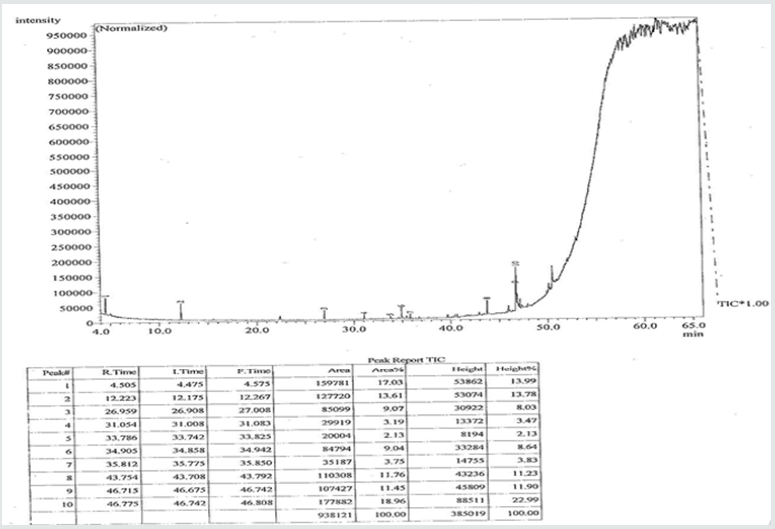
Figure 3: The relationship between time and intensity of fragmentation that produced peaks in the leaves of Gossypium
barbadense.
Abbreviations and formulae of calculation.
R. time = retention time. % area = area of peak X100%
I time = initial time. Total area
F. time = full time. % height = height of peak X100%
Total height
TIC = (total ions chromatography)
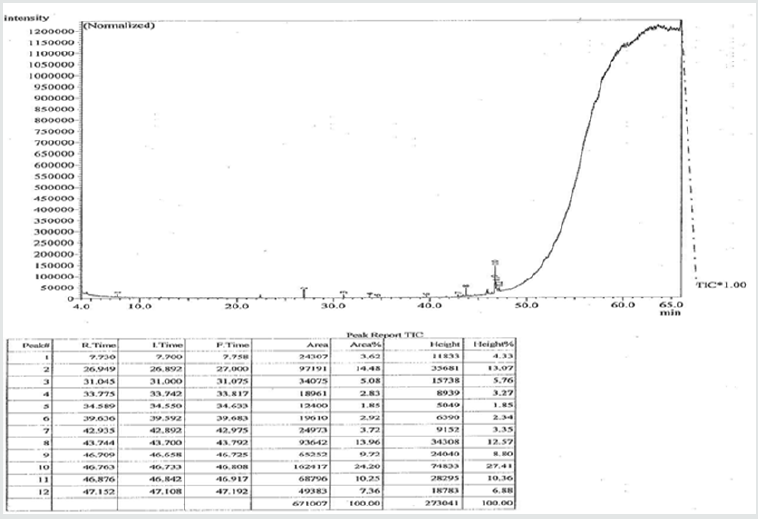
Conclusion
The modern health care services in South Kordofan and Blue Nile are not adequate because of few care centers and hospitals and the most people cannot afford to buy drugs prescribed due to their low income. Leaves of the selected members of family Malvaceae were recommended because of their beneficial health. Due to this information’s flavonoids can be used as antifungal, antibacterial, antiviral and strengthen of muscles beside antioxidant to prevent the most types of cancers.
Acknowledgement
The authors are very grateful to the laboratories in the central laboratory for sharing their knowledge through this study.
References
- Johns WP, Douglas A (2005) National products isolation 20(9): 323 - 351.
- Wilkomirsk B, Dubielecka B, Mazan D (1998) Significant of the flavonoid levels in the phonetic taxonomy of the genus Betula 132(3): 233-238.
- Williams CA, Richardson J, Greenham J, Eagles J (1993) Correlation between leave flavonoids, taxonomy and plant geography in the genus Disporum. Phytochemistry 34(1): 197-203.
- Buttery BR, Buzzell RI (1973) Varietal differences in the leaf flavonoids of soybeans. Crop Science 13(1): 103 -106.
- Donatus EO, Benson UI (2010) GC-MS evaluation of bioactive compounds and antibacterial activity of the oil fraction from the leaves of Alstonia boonei . Department of Chemistry 2(1): 261-272.
- Christy S, Anusha B (2012) GC-MS analysis of phytocomponents in the methanolic extract of Eupatorium triplinerve. International Journal of Drug Development and Research 4(4): 148-153.
- Farooq Anwar, Omar Rashid, Mohammed A, Mohammed N (2010) Okra, Hibiscus esculentus seed oil for biodiesel production. Applied Energy 87(3): 779-785.
- Havsteen BH (2002) The biochemistry and medical significance of the flavonoids. Pharmacology&Therapeutics 96(2-3): 67-202.
- Saija A, Scales M, Lanza M, Marzullo D, Bonina F, et al. (1995) Flavonoids and antioxidant agent: importance of their interaction with biomembranes. Free Radical Biology Medicine 19(4): 481-486.

Top Editors
-

Mark E Smith
Bio chemistry
University of Texas Medical Branch, USA -

Lawrence A Presley
Department of Criminal Justice
Liberty University, USA -

Thomas W Miller
Department of Psychiatry
University of Kentucky, USA -

Gjumrakch Aliev
Department of Medicine
Gally International Biomedical Research & Consulting LLC, USA -

Christopher Bryant
Department of Urbanisation and Agricultural
Montreal university, USA -

Robert William Frare
Oral & Maxillofacial Pathology
New York University, USA -

Rudolph Modesto Navari
Gastroenterology and Hepatology
University of Alabama, UK -

Andrew Hague
Department of Medicine
Universities of Bradford, UK -

George Gregory Buttigieg
Maltese College of Obstetrics and Gynaecology, Europe -

Chen-Hsiung Yeh
Oncology
Circulogene Theranostics, England -
.png)
Emilio Bucio-Carrillo
Radiation Chemistry
National University of Mexico, USA -
.jpg)
Casey J Grenier
Analytical Chemistry
Wentworth Institute of Technology, USA -
Hany Atalah
Minimally Invasive Surgery
Mercer University school of Medicine, USA -

Abu-Hussein Muhamad
Pediatric Dentistry
University of Athens , Greece

The annual scholar awards from Lupine Publishers honor a selected number Read More...





